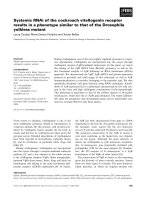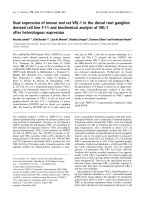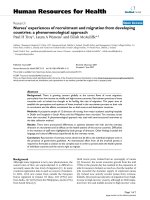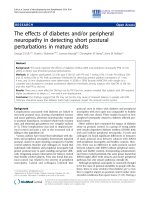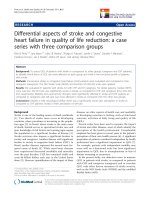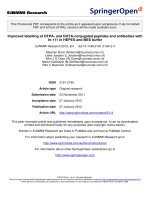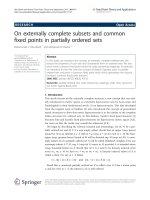Báo cáo toán học: "Optimal Packings of 13 and 46 Unit Squares in a Square" pps
Bạn đang xem bản rút gọn của tài liệu. Xem và tải ngay bản đầy đủ của tài liệu tại đây (990.3 KB, 11 trang )
Optimal Packings of 13 and 46
Unit Squares in a Square
Wolfram Bentz
Department of Mathematics, Statistics, and Computer Science
St.Francis Xavier University
Antigonish, Nova Scotia, Canada
Submitted: Aug 31, 2009; Accepted: Sep 6, 2010; Published: Sep 13, 2010
Mathematics Subject Classification: 05B40, 52C15
Abstract
Let s(n) be the side length of the smallest square into which n non-overlapping
unit squares can be packed. We show that s(m
2
− 3) = m for m = 4, 7, implying
that the most efficient packings of 13 and 46 squares are the trivial ones.
The study of packing unit squares into a square goes back to Erd˝os and Graham [2],
who showed that large numbers of unit squares can be packed in a way that is surprisingly
efficient. G¨obel [5] later addressed the problem of finding efficient packings for a given
number n of unit squares, and the subject was subsequently published in the popular
science literature in various articles by Gardner [4].
Let s(n) be the side length of the smallest s quare into which n non-overlapping unit
squares can be packed. Non-trivial cases for which s(n) is known are s(m
2
−1) = s(m
2
−
2) = m for m 2 (Nagamochi [7], single values previously shown by G¨obel [5], El Moumni
[1], and Friedman [3]), s(5) = 2 +
1
2
(G¨obel [5]), s(6) = 3 (Kearney and Shiu [6]), and
s(10) = 3 +
1
2
(Stromquist [9]). There are moreover non-trivial best packings and lower
bounds known for various values of n. An introduction to the problem, as well as an
overview of the basic techniques used in the following can be found in the survey article
by Friedman [3].
We will show s(m
2
−3) = m for m = 4, 7, which implies that the optimal packings of
13 and 46 squares are the trivial ones with all edges of the unit squares either parallel or
perpendicular to those of the containing square. While our results strongly suggest that
the same formula holds for the intermediate values m = 5, 6, no specialized results are
currently known in these cases, for which the best established packings are trivial, and
the best lower bounds follow from the general formula given in Nagamochi [7].
Following Stromquist, let a box be the interior of any square larger than unit size.
In our results, we will establish that m
2
− 3 squares cannot be packed in a square with
the electronic journal of combinatorics 17 (2010), #R126 1
side length smaller then m by proving the equivalent statement that it is impossible to
pack m
2
− 3 boxes in a square of side length m. Various configurations of points will
be constructed so that each box inside our square will either have to contain one of the
points or otherwise be restricted to a small area.
We begin by listing technical lemmas in Section 1. The proofs for m = 7, 4 (n = 46, 13)
are then given in sections 2, 3, respectively.
1 Technical lemmas
In this section, we present a range of “non-avoidance” lemmas, as well as various results
dealing with boxes of restricted movement. Non-avoidance lemmas state that if the centre
of a box is in some region, the b ox must intersect some part of the region’s boundary. The
other results draw consequences if a box has its centre in some region without intersecting
particular boundary points.
Lemma 1 (Nagamochi [7], Stromquist [8]) A box whose centre is in the rectangle
[0, 1] ×[0, 1] and which does not intersect the axes must contain the points (1, 1), (0.9, 1),
and (1, 0.9) (and hence the triangle spanned by these points).
Lemma 2 (Friedman [3], Stromquist [8]) Let T be a triangle with sides of length at
most 1. Then any box whose centre is in T must contain one of the vertices of T .
Corollary 3 Let 0 < a, b 1 and c such that both c
2
+ b
2
1 and (a − c)
2
+ b
2
1.
Then if a box has it centre inside the rectangle R with vertices H(0, 0), I(0, b), J(a, b),
K(a, 0), it covers a vertex or the point L(c, 0). In particular, if b <
1
2
√
3, the box covers
a vertex or the midpoint of the line segment HK.
Proof: The bounds on a, b imply that Lemma 2 is applicable to the triangles HLI, ILJ,
and JLK, which form a subdivision of [0, a] ×[0, b]. Hence the centre of the box is in one
of the triangles, and the result follows.
Lemma 4 (Friedman [3], Stromquist [8]) Let a 1, b 1, and a + 2b 2
√
2, then
any box whose centre is in the rectangle [0, a] × [0, b] must intersect the x-axis, the point
(0, a) or the point (a, b).
We will usually use Lemma 4 in the cases of a < 2
√
2 − 2 ≈ 0.828, b = 1 and a = 1,
b <
√
2 −
1
2
≈ 0.914.
Lemma 5 (Stromquist [8], [9]) Let 2
√
2 − 2 < a < 1, 0 < b < 1, and (a, b) within a
distance of 1 from (0, 1). Moreover, let f (a) be the infimum of
cos θ
1 + cos θ
+
1 − a cos θ
sin θ
(1)
the electronic journal of combinatorics 17 (2010), #R126 2
for θ ∈ (0,
π
4
]. If b < f(a), then any box whose centre is in the quadrilateral with vertices
(0, 0), (0, 1), (a, 0), and (a, b) must intersect the x-axis, the point (0, 1) or the point (a, b).
Moreover, the infimum of (1) is a minimum and is obtained at a value of θ satisfying
2 cos
3
θ −(2a + 2) cos
2
θ + (a
2
− 2a + 3) cos θ −(1 −a
2
) = 0. (2)
We will be using Lemma 5 in the cases a =
1
2
√
3, b = 0.5; a 0.89, 0.6 < b 0.921;
a = 0.90, b = 0.90; and a = 0.96, b = 0.76. Note that f(a) is decreasing in a.
1
Lemma 6 (Stromquist [8]) Let L
1
and L
2
be two parallel lines of distance d 1, and
B a box with its centre between them. Then B must intersect the two lines with a common
length of intersection of at least min{1, 2
√
2 − 2d}.
We will use the Lemma in the situation of the following corollary, which will be a
major technical tool for this article.
Corollary 7 Let 0 < b 1, and R be the rectangle with vertices (0, 0), (0, 1), (b, 0), (b, 1).
Then any box whose centre lies inside R without containing any of its vertices intersects
the line segments {0} ×[0, b] and {1} ×[0, b] with a common length of intersection of at
least 2
√
2 − 2 ≈ 0.828. In addition, if 2
√
2 − 2 > b then the box intersects each segment
with a length of at least b − 2
√
2 + 2.
In the situation of Corollary 7, we will simply refer to the (length of the) intersection
of the box with one of the edges of R as being the left, right, up, or down intersection.
2 46 Squares
The non-avoidance lemmas can be used dire ctly to prove the following theorem, imply-
ing that s(46) = 7, and that the optimal packing of 46 is the trivial one. Its proof is
surprisingly simple for such a large case, in particular when compared to the case of 13
squares.
Theorem 8 46 non-overlapping unit squares cannot be packed in a square of side length
less than 7.
Proof: Let S be the square [0, 7]
2
and consider the collection of 45 points depicted in
Figure 1. The points in the lowest row are
i,
√
2 −
1
2
i = 1, 2, . . . , 6,
1
In its original form the Lemma states incorrectly that the smallest positive θ satisfying (2) realizes
the minimum of (1). In fact, the minimum values in some of our cases corresponds to the second largest
positive root of (2).
the electronic journal of combinatorics 17 (2010), #R126 3
and the remaining ones are arranged so that all shown triangles are equilateral of side
length 1. Note that the points in the uppermost row have y-value
√
2 −
1
2
+ 6 ·
√
3
2
> 6.11,
and are less than
√
2−
1
2
from the upper edge of S. Lemma 2 is applicable to the triangles,
Lemma 4 to the rectangles, and Lemma 5 to the remaining quadrilateral regions (with
a =
√
3
2
, b =
1
2
). Thus any box placed inside S must contain one of the points, showing
that no more than 45 boxes can be placed in S. The result follows.
Figure 1: Unavoidable set with 45 p oints
3 13 Squares
In this section we will prove the following theorem, implying that s(13) = 4.
Theorem 9 13 non-overlapping unit squares cannot be packed in a square of side length
less than 4.
From now on, let S be the square [0, 4]
2
, and assume that 13 boxes are packed into
S. Consider first the configuration of 16 points as shown in Figure 2. Four points have
coordinates
A(1, 0.914), B(0.914, 1), C(0.914, 2), D(1.65, 1.65)
while the remaining ones are obtained through mirroring at the lines x = 2, y = 2, and
y = x.
Non-avoidance lemmas apply to all regions, so each box contains at least one point.
With 13 boxes and 16 points, at least 10 boxes contain exactly one point. This implies
that of the eight points closest to the corners of S, at least two are in a box that does not
contain another point. We will refer to two such boxes (arbitrarily selected if necessary)
as being “corner restricted”.
the electronic journal of combinatorics 17 (2010), #R126 4
Figure 2: Initial configuration for 13 squares
Lemma 10 If a box T covers A(1, 0.914) but not any other point in Figure 2, then
it contains (1.12, 1), (1, 1.74), and (1.87, 0.76) (and hence the convex hull of these four
points).
Proof: This follows as the set stays unavoidable if A is replaced by any of the other
points.
We will distinguish two cases of placements of the corner-restricted boxes.
3.1 Non-adjacent corner-restricted boxes
Without losing generality we may assume that one of the corner-restricted boxes c overs
point A. In this section we assume that the other corner-restricted box does not cover
point B. In this situation, regardless of how the second box is placed, a common non-
avoidable structure can be created, provided that minor adjustments are performed.
To this end, we will define 10 points and 4 pairs of alternative points. Three points
are placed at (1, 1.74), (2, 1.74), and (1.6, 1), while one pair consists of the points A and
B from above. The remaining points and pairs are obtained by mirroring along the lines
x = 2 and y = 2.
After one point of each pair of alternatives is chosen, 14 points are placed so that
non-avoidability lemmas apply to all but two of the bounded regions in Figure 3 (for
readability, the various alternative choices are demonstrated in different corners). The
two critical regions are [1, 2] × [1.74, 2.26] and [2, 3] × [1.74, 2.26].
Note that each corner-restricted box will contain one point of an alternative pair. From
now on assume that, if possible, we will pick a point contained in a corner-restricted
box whenever choosing from a pair of alternatives. Note that our assumptions on the
placements of the corner-restricted boxes imply that every pair point contained in a corner-
restricted box will end up in our configuration.
In addition to these points, each corner-restricted box will contain one of (1, 1.74),
(1.6, 1), or their symmetric counterparts by Lemma 10.
the electronic journal of combinatorics 17 (2010), #R126 5
Figure 3: One square has its centre in one of the marked regions
Hence four of the 14 points are covered by two boxes. Of the remaining 11 boxes, at
least one cannot contain a point and thus its centre is in one of the above regions. By
symmetry, we may assume that the centre lies in [1, 2] × [1.74, 1.26] (asymmetries due to
the placement of the corner-restricted boxes will not affect any of the following).
Consider a new configuration of 11 points and four pairs of alternative points. The
pairs are the same as in the previous case. Six points are (1.6, 1), (2.26, 1), (3, 1.6),
(1, 1.74), (1.78, 1.74), (2.26, 2), and the others are obtained by mirroring at the line y = 2.
Non-avoidance lemmas apply to all the regions in Figure 4, regardless of which point of
an alternative pair is chosen (note that once again in each corner just one alternative is
displayed).
Figure 4: One box covers both marked points
For each such choice, the resulting set consists of 15 points, and as before, the corner-
restricted boxes contain two points each. In addition, the box that lies with its centre
inside [1, 2] × [1.74, 1.26] contains the points (1.78, 1.74) and (1.78, 2.26) by Corollary 3.
Hence six of the 15 points are contained in three boxes, and as the set is unavoidable,
only nine more boxes can be packed inside S, for a maximum of twelve.
the electronic journal of combinatorics 17 (2010), #R126 6
3.2 Adjacent corner-restricted boxes
In this section we assume that one box covers point A and the other covers point B. We
will refer to these boxes as T
A
and T
B
, res pectively. We will first show that due to their
proximity, one box covers an extended area. The following Lemma follows analogously to
Lemma 10.
Lemma 11 In the situation of Lemma 10, assume that a box T does cover point A, but
does not cover B, C, or D, and, in addition, does not cover the point (1, 1). Then the
box contains the points (1.82, 1) and (1.96, 0.76).
Now of the two corner-restricted boxes T
A
and T
B
, at most one of them covers the
point (1, 1), and hence Lemma 11 (or its symmetric version) applies to the other one.
Without loss of generality, we may assume this to be the box T
B
.
Unlike in the case of two non-adjacent corner-restricted boxes, different configurations
need to be constructed for various subcases. However, there is a common set of points
that can be included in all of them. Let
S
A
= {A, (1.13, 1), (1.4, 1), (1.74, 1), (1.87, 0.76)},
S
B
= {B, (1, 1.13), (1, 1.82), (0.76, 1.96)}
By Lemmas 10 and 11, the points in S
A
, S
B
are covered by T
A
and T
B
, respectively.
Consider the set
S
A
∪ S
B
∪ {(2.5, 1), (3, 1)} ∪({1, 2, 3} × {1.82, 2.36, 3.09})
(see Figure 5). Non-avoidance lemmas apply to all regions with the exception of the four
rectangular ones bounded by the points in {1, 2, 3} × {1.82, 2.36, 3.09}. We will refer to
this regions as R
1
, R
2
, R
3
, and R
4
, numbered clockwise from the top left.
Figure 5: Configuration with four critical regions
the electronic journal of combinatorics 17 (2010), #R126 7
The above list contains only 10 points that are not already covered by T
A
or T
B
(note
that (1, 1.82) is listed twice) and hence in order to pack 13 boxes into S, there must be a
box T
not containing any point.
We will now go through the potential placements of T
into the critical regions and
will construct (occasionally after restricting to subcases) “small enough” unavoidable sets
of points. Here “small enough” means that the number of points not known to be covered
by already placed boxes and the number of those placed boxes is smaller than 13.
By Corollary 3 in the cases b = 0.73 (R
1
, R
2
) and b = 0.54 (R
3
, R
4
), T
will contain
the midpoints of the longer edges of its corresponding region. We will refer to these sets
of midpoints as S
1
, . . . , S
4
, respectively, and will include them in our non-avoidable sets.
3.2.1 The centre of T
lies in region R
1
Consider the following set of 18 points:
S
A
∪ S
B
∪ S
1
∪
{(2.5, 1), (3, 1), (2, 1.82), (3, 1.82), (2.3, 2.5), (3, 2.5), (1, 3), (2.3, 3), (3, 3)}
If we add an additional “sliding p oint” Z on the line segment {1} × [2.36, 2.92], these
points are non-avoidable regardless of the actual placement of Z (see Figure 6; for Z
having a high y-value, this follows from Lemma 5 with a 0.96, b = 0.76).
Figure 6: Case R
1
, including a “sliding” point
Now by Corollary 7, T
has a left intersection of at least 0.09. Hence either T
contains
(1, 3) or intersects {1}×[2.45, 2.91]. In both cases (with an appropriately placed Z), there
are nine points which are not covered by T
A
, T
B
, or T
, and the set is small enough.
3.2.2 The centre of T
lies in the region R
2
We will consider two subcases:
the electronic journal of combinatorics 17 (2010), #R126 8
1. T
covers (2, 2.72)
The following is a small enough non-avoidable set (Figure 7):
S
A
∪ S
B
∪ (S
2
∪ {(2, 2.72)}) ∪
{(2.5, 1), (3.1, 1), (2.5, 1.6), (1.6, 1.95), (3.1, 2), (1, 2.72), (1, 3), (1.8, 3)}
Figure 7: Case R2 (1.)
2. T
does not cover (2, 2.72)
Then the left intersection of T
is smaller than 0.37. By Lemma 7 the right intersec-
tion of T
must be at least 0.45, which implies that T
contains the point (3, 2.64).
A small enough unavoidable set is the given by (Figure 8)
S
A
∪ S
B
∪ (S
2
∪ {(3, 2.64)}) ∪
{(2.5, 1), (3, 1), (2, 1.82), (3, 1.82), (1, 2.36), (1.5, 2.36), (1, 3), (1.8, 3), (3, 3)}.
3.2.3 The centre of T
lies in the region R
3
Consider the unavoidable se t (Figure 9)
S
A
∪ S
B
∪ (S
3
∪ {(3, 2.10)}) ∪
{(2.3, 1), (3.05, 1), (1.8, 1.8), (3, 1.86), (1, 2.14), (2, 2.14), (1, 3), (1.5, 3), (2.3, 3), (3.1, 3)}
Note that as the right intersection of T
is at least 0.28, T
covers (3, 2.10). In addition,
either its left intersection exceeds 0.32 or its right intersection exceeds 0.50. Hence T
also
covers one of (2, 2.14) or (3, 1.86), and the set is small enough.
the electronic journal of combinatorics 17 (2010), #R126 9
Figure 8: Case R
2
(2.)
Figure 9: Case R
3
3.2.4 The centre of T
lies in region R
4
As in the previous case, we have that T
covers (1, 2.10) and (2, 2.10). A small enough
unavoidable set is given by (Figure 10)
S
A
∪ S
B
∪ (S
4
∪ {(1, 2.10), (2, 2.10)}) ∪
{(2.5, 1), (3.1, 1), (2.4, 1.6), (3.1, 2), (2.4, 2.5), (0.9, 3), (1.7, 3), (2.5, 3), (3.1, 3)}.
By 3.1 and cases 3.2.1 to 3.2.4, Theorem 9 follows.
Acknowledgment
The author would like to thank the anonymous referee for his helpful suggestions.
the electronic journal of combinatorics 17 (2010), #R126 10
Figure 10: Case R
4
References
[1] S. El Moumni, Optimal Packings of Unit Squares in a Square, Studia Sci. Math.
Hungar. 35 (1999), no. 3-4, 281-290.
[2] P. Erd˝os and R. L. Graham, On Packing Squares with E qual Squares, J. Combin.
Theory Ser. A 19 (1975) 119-123.
[3] E. Friedman, Packing unit squares in squares: A survey and new results, The Elec-
tronic Journal of Combinatorics, Dynamic Surveys (#DS7) (version of Aug 14, 2009)
[4] M. Gardner, “Mathematical Games”, Scientific American (Oct 1979, Nov 1979, Mar
1980, Nov 1980).
[5] F. G¨obel, Geometrical Packing and Covering Problems, in Packing and Covering in
Combinatorics, A. Schrijver (ed.), Math Centrum Tracts 106 (1979) 179-199.
[6] M. Kearney and P. Shiu, Efficient Packing of Unit Squares in a Square, Elect. J.
Comb. 9 #R14 (2002).
[7] H. Nagamochi, Packing Unit Squares in a Rectangle, Elect. J. Comb. 12 #R37
(2005).
[8] W. Stromquist, “Packing Unit Squares Inside Squares I, II, III”, unpublished
manuscripts, 1984-5; />[9] W. Stromquist, Packing 10 or 11 Unit Squares in a Square, Elect. J. Comb. 10 #R8
(2003).
the electronic journal of combinatorics 17 (2010), #R126 11
